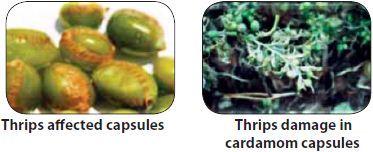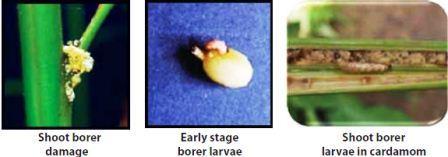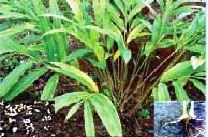Small cardamom: Insect Pests Management
Small cardamom: Insect Pests Management
Cardamom thrips
Biology- Egg: Eggs are kidney shaped laid singly in the tender part of the leaf sheath, racemes
- Nymph: Nymphs tiny, slender, fragile and straw yellow in colour
- Adult: Minute, dark greyish brown, 1.25 to 1.5 mm long and with fringed wings.
 Panicles become stunted
Panicles become stunted- Shedding of flowers and immature capsules thus reducing the total number of capsules formed.
- Infestation causes formation of corky encrustations on capsule resulting in their malformed and shriveled condition.
- Such pods lack their fi ne aroma and the seeds within are also poorly developed.
- Predators: Lacewing, big-eyed bug, Orius laevigatus, Thripoctenus americensi etc.
Shoot, panicle and capsule borer
Biology- Egg: Eggs are pink, oval, flat and laid singly or in groups on the tender part of the plant
- Larva: Long, pale greenish with a pinkish colour dorsally, head and pro-thoracic shield brown in colour and body covered with minute hairs.
- Pupa: Pupation takes place in lose silken cocoon in larval tunnel.
- Adult: Medium sized moth (22-24mm); the wings are pale yellowish with black spots on the wings.
 Early stage of the larva bores the unopened leaf buds and feeds on the leaf tissue.
Early stage of the larva bores the unopened leaf buds and feeds on the leaf tissue.- They also bore the panicles leading to drying up of the portion from the affected spot
- Feed on immature capsules and the young seeds inside rendering the capsules empty.
- Late stage larvae bore the pseudostem and feed on the central core of the stem resulting in drying of the terminal leaf and thus produce characteristic ‘dead heart’ symptom.
- Oozing out of frass material at the point of tunnelling is the indication for the presence of larva inside the plant parts.
- The incidence of this pest is noticed throughout the year but they occur in enormous number in four periods, December-January, March-April, May-June and September-October and their abundance synchronizes with the panicle production, fruit formation and new tiller production.
- Parasitoids: Trichogramma chiloni, Tetrastichus spp., Apanteles sp, Eriborus sp, Friona sp, braconid wasp,Telenomus spp., Xanthopimpla australicus, Agrypon sp etc.
- Predators: Lacewing, ladybird beetle, King crow, dragonfl y, spider, robber fl y, reduviid bug, praying mantis, earwig, red ant etc.
Early capsule borer
Biology- Egg: Eggs are spherical, greenish white laid on the panicled flower.
- Larva: Larvae are flat, trowel shaped covered with dense hairs covering all over the body.
- Pupa: Small and brownish in colour and pupates in the debris near the panicle.
- Adult: The wings of moth are bluish with metallic lustier on the upper surface and bordered with a white thin line and black shade
- Caterpillars bore and feed on the inflorescence, flower buds, flowers and capsules.
- Affected capsules become empty with a big circular hole, turn yellowish – brown which decay and drop off in the rainy season.
- Parasitoids: Trichogramma spp., Tetrastichus spp., Apanteles spp., Braconid wasp etc.
- Predators: Lacewing, ladybird beetle, King crow, dragonfly, spider, robber fly, reduviid bug, praying mantis, earwig, red ant etc.
White grub/root grub
BiologyAmong the three species B. fulvicorne is found to cause more damage in cardamom tracts.
- Egg: Eggs are pale yellow in colour.
- Grub: Grubs are short, stout, ‘C’ shaped, pale white in colour.
- Adult: Beetles are shiny, metallic blue, bluish green, greenish brown or brown in colour.
 The grubs feed on the roots in the form of irregular scraping.
The grubs feed on the roots in the form of irregular scraping.- In advanced stages entire root system is found damaged resulting in drying and rotting depending on the season of attack.
- In the severely infested plants, leaves turn yellow and dry.
- Predators: Lacewing, ladybird beetle, King crow, dragonfly, spider, robber fly, reduviid bug, praying mantis, earwig, red ant etc.
Cardamom whitefly
Biology- Egg: Eggs are cylindrical, pale yellow in colour when freshly laid and gradually turn brown.
- Nymph: Nymphs are elliptical and pale green in colour. There are four nymphal stages.
- Adult: Adults are small soft bodied insect, about 2 mm long and having two pairs of white wings. The life cycle is completed within two-three week.
- Damage to the plant is caused by the depletion of sap from leaves.
- In severe infestation the leaves turn yellow and the vigour and growth of the plant get considerably reduced.
- The nymphs secrete sticky honeydew, which drops on to lower leaves. On these, black sooty mould develops, which interrupts photosynthesis of the leaves.
Warm weather conditions are favourable for multiplication Natural enemies of whitefly:
- Parasitoids: Encarsia spp., Eretmocerus spp., Chrysocharis spp. etc.
- Predators: Lacewing (Mallada boninensis), big-eyed bug, ladybird beetle, dragonfly, spider, predatory mites etc.
Hairy caterpillars
Biology- Egg: Eggs are dome shaped and laid on undersurface of the leaves of shade trees.
- Larva: Larvae are robust, bluish black with pale brown head, white hairs and dorsal conical tuft of hairs.
- Pupa: Pupation takes place in soil/plant debris.
- Adult: Large moths, pale yellow with wavy lines and a series of spots near the outer margin of wings
- Caterpillars are gregarious in habit and they congregate on the trunks of shaded trees during day time and drop down on the cardamom plants during night time.
- They fed voraciously on leaves and defoliate the whole cardamom plants.
- Usually the damage is observed during October-December.
- These appear sporadically in enormous populations at intervals of several years and cause heavy damage to the foliage.
- Predators: Lacewing, ladybird beetle, King crow, dragonfly, spider, robber fly, reduviid bug, praying mantis, earwig, red ant etc.
Shoot fly
Biology- Egg: Eggs are cigar shaped and white colour and are laid in between leaf sheath and pseudostem on the whorl.
- Larvae feed on the growing shoot of the young cardamom suckers.
- Emerging maggots (larvae) enter the pseudostem reach down the base by feeding the core tissue resulting in drying of the terminal leaf.
- Infestation is more on plants in open area; the pest activity starts during November and is at its peak in March-April.
- Parasitoid: Opius mudigerensis (larval)
- Predators: Lacewing, ladybird beetle, King crow, dragonfly, spider, robber fly, reduviid bug, praying mantis, earwig, red ant etc.
Mid rib caterpillar
Biology- Egg: Eggs are spherical in shape.
- Larva: Larvae are pale green in colour and 1 cm long when fully grown. Large black dots are present dorsally on head and the last abdominal segment.
- Pupa: Pupae are silken cocoon
- Adult: Adults are black brown in colour moths having two golden stripes on their wings.
- Caterpillars of this insect feed on unopened leaves of cardamom.
- Larva makes a hole almost at the middle of an unopened leaf, enter through the hole and feed on one half of the lamina as well as part of the mid rib from its point of entry.
- Predators: Lacewing, ladybird beetle, King crow, dragonfly, spider, robber fly, reduviid bug, praying mantis, earwig, red ant etc.
Cardamom aphid
Biology- Nymph: Nymphs are dark in colour.
- Adult: Adults are brown in colour and has black veined wings. They reproduce by viviparous and parthenogenetically
- Both nymphs and adults suck up plant sap.
- Colonies of aphids are seen under concealed conditions inside leaf sheaths of the older pseudostems.
- Parasitoids: Aphidius spp., Aphelinus spp. etc
- Predators: Ladybird beetle, lacewing, spiders, hover fly etc.
Rhizome weevil
Biology- Egg: Adult weevil lays eggs in punctures made by it on the exposed portion of the rhizome.
- Adult: Adults are brown in colour in 12 mm length with 3 black lines on the pronotum, one mid dorsally and other 2 on either sidel elytra 3 black dots, two anteriorly and one posteriorly. Adults emerge immediately after the summer rains in April. Adults live for 7-8months
- The grubs feed on the rhizome and basal portion of the stem, which results in the drying of the leaves and breaking up of the stem at the base.
- The pest becomes a serious menace in secondary nursery during November-January.
- Predators: Earwig, King crow, dragonfly, spider, reduviid bug, praying mantis, red ant etc.
Red spider mites
Biology- Egg: Eggs are hyaline , globular laid in mass
- Nymphs: Nymphs are yellowish in colour
- Adult: Adults are red coloured small size
- Affected leaves become reddish brown and bronzy.
- Severe infestation, silken webbing on the leaves.
- Leaves wither and dry.
- Flower and fruit formation affected.
- Warm weather conditions are favourable for multiplication.
- Predators: Predatory mites (Phytoseiulis persimilis, Neoseiulis cucumeris), predatory beetles such as small staphilinidae (Oligota spp.) and ladybird beetles, lacewings, predatory thrips, anthocorid bugs (Orius spp.), mirid bugs, predatory flies (hover flies) etc.
Root-knot nematode
Biology- Most species of plant parasitic nematodes have a relatively simple life cycle consisting of the egg, four larval stages and the adult male and female. They are microscopic in size.
- Development of the first stage larvae occurs within the egg where the first moult occurs. Second stage larvae hatch from eggs to find and infect plant roots or in some cases foliar tissues.
- Under suitable environmental conditions, the eggs hatch and new larvae emerge to complete the life cycle within 4 to 8 weeks depending on temperature.
- Nematode development is generally most rapid within an optimal soil temperature range of 70 to 80° F.
- Root-knot nematode infests cardamom roots.
- Common symptoms of attack are narrowing of leaves, thickening of veins, reduction of internodes length and consequent appearance of rosette leaves.
- Roots branch heavily and galls appear on them.
- Plant growth becomes highly stunted
- Primary: Egg masses in infected plant debris and soil or collateral and other hosts such as Solanaceous, Malvaceous and Leguminaceous plants act as sources of inoculum
- Secondary: Autonomous second stage juveniles that may also be water dispersed
- Loamy light soils
IPM for Small Cardamom
To know the IPM practices for Small Cardamom, click here.
Source: NIPHM and Directorate of Plant Protection, Quarantine & Storage
Last Modified : 12/11/2019
© C–DAC.All content appearing on the vikaspedia portal is through collaborative effort of vikaspedia and its partners.We encourage you to use and share the content in a respectful and fair manner. Please leave all source links intact and adhere to applicable copyright and intellectual property guidelines and laws.
RELATED ITEMS
Black Pepper: Insect and Nematode Pests Management
This topic covers the information related to Insec...
Grapes: Insect Pests Management
This topic covers the information related to Insec...
Blackgram & Greengram: Insect, Mite and Nematode Pests Management
This topic covers the information related to Insec...
Arecanut Insect Pests
This topic covers information about Arecanut Inse...
